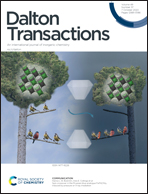Crystal structure, theoretical studies and luminescent properties of a new borate Na3GdB8O15 with one-dimensional broad-banded anionic framework†
Abstract
Inorganic borate compounds exhibit significant diversity in their structure types, which are associated with interesting optical and magnetic properties. In our work, a new rare-earth polyborate Na3GdB8O15 was prepared with an infinite one-dimensional (1D) broad-banded framework of [B8O15]∞ running along the a-axis, in which large Gd3+ and Na+ ions reside to ensure cohesion and neutrality of the structure. The basic fundamental building block (FBB) of [B8O15]∞ is B16O32, which is composed of five BO3 and three BO4 groups and can be written as 5Δ3□: 〈2Δ□〉 − 〈Δ2□〉〈2Δ□〉. First principle studies reveal that Na3GdB8O15 is an indirect bandgap semiconductor and the optical absorption at 280 nm originates from the O2− → Gd3+ transition. Solid solutions of Na3Gd1−xCexB8O15 and Na3Gd0.98−yYyCe0.02B8O15 were prepared and exhibited a bluish violet emissive luminescence by near-UV excitation due to the 5d1 → 4f1 transition of Ce3+. Substitution of Gd3+ by Y3+ enhanced the luminescence efficiency and significantly improved the thermal stability. At 423 K, the luminescence intensity of Na3Gd0.58Y0.4Ce0.02B8O15 remained 77% of that at 298 K. We hypothesize that Na3GdB8O15 is a potential inorganic luminescent host matrix.



 Please wait while we load your content...
Please wait while we load your content...